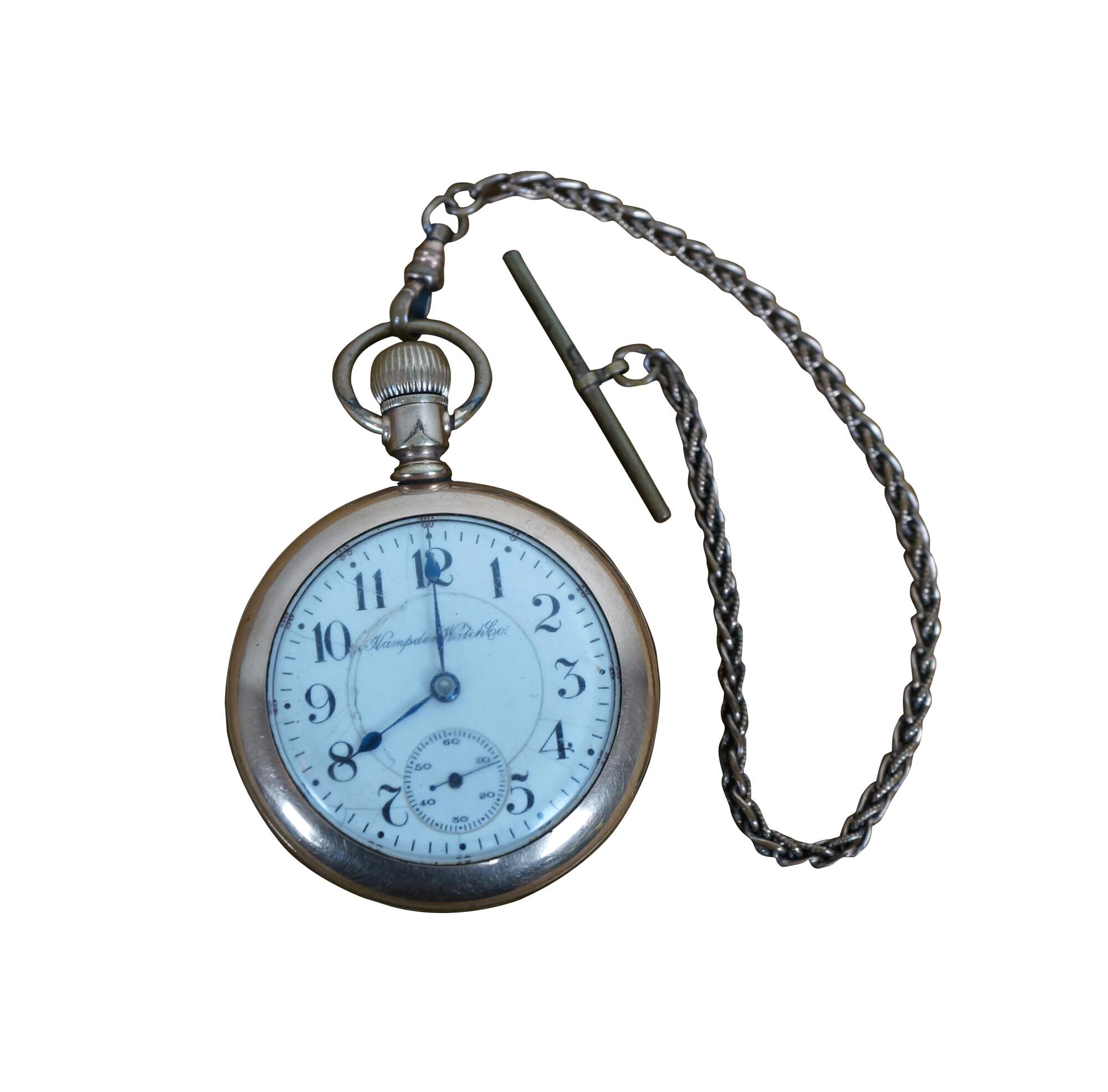
Shipping:
Free Shipping Included
Delivery:
Estimated 2-15 Business Days
Payments:
Credit Card, Check, Cash, PayPal, Apple Pay, Venmo
Returns:
30 Days 100% Money Back Guarantee, Buyer Pays Return Shipping
Description
Circa 1912 Hampden Watch Company pocket watch and wheat link watch chain. White face with black Arabic numerals and auxillary dial. Case by Philadelphia Watch Case Company - Guaranteed Twenty Years - 10K Gold Filled - 8278053 - 08278053. Movement grade: The Duebar Watch Company of Canton, OH - Double Roller Adjusted to Five Positions - 21 Jewels - 3031904. Monogram on reverse (DJP?)
The Hampden Watch Co. manufactured watches in Springfield, Massachesetts and Canton, Ohio from approximately 1877 to 1927. Predecessor: New York Watch Co. Dueber was a grade of pocket watch movements manufactured by Hampden Watch Co.. June 1877 - The New York Manufacturing Co. is reorganized as the Hampden Watch Co. 1881 - A new factory for the Hampden Watch Co. is constructed in Springfield, Massachusetts. 1886 - John C. Dueber purchases a controlling interest in the Hampden Watch Co. Looking to expand the watch production, Dueber explored suitable land in Springfield, Massachusetts for a new factory. However, his search was unsuccessful. Dueber begins looking for a place to relocated his watch case company and the Hampden Watch Co. 1888 - John C. Dueber moves The Dueber Watch Case & Manufacturing Co. from Newport, Kentucky to Canton, Ohio and rebrands the company as the Dueber Watch Case Works to provide cases for the Hampden Watch Works company. April 1888 - The Hampden Watch Co. is relocated to Canton, Ohio. and rebranded as Hampden Watch Works. 1907 - John C. Dueber passes away and Albert M. Dueber takes over the Dueber Watch Case Works. 1923 - The Hampden Watch Works and Dueber Watch Case Works merge to form the Dueber-Hampden Watch Co. 1925 - The Dueber-Hampden Watch Co. is purchased by Walter Vretmann. 927 - The Dueber-Hampden Watch Co. goes into receivership. 1930 - The Dueber-Hampden Watch Co. is purchased by a company in Russia. All equipment and some employees were relocated overseas.
Philadelphia Watch Case Co. Years of Operation: c.1889 - 1953. Predecessor: H. Muhrs Son. Successor: Keystone Watch Case Co. In 1884, Theophilus Zurbrugg formed a partnership with Daniel Leichty and Jacob Ott to manufacture cases in Philadelphia, Pennsylvania. Theophilus Zurbrugg & Co. manufactured cases at 140 South Third Street. Within a few years, Zurbrugg acquired the interests of the other members and organized the Philadelphia Watch Case Company around 1889. As the business expanded, Zurbrugg began looking for a location for a new factory. In 1892, the company was relocated to Riverside, New Jersey. In March 1898, Zurbrugg was able to absorb the case operation owned by H. Muhr's Sons, representing one of many consolidations implemented by Zurbrugg to commandeer market share. As explained in a public letter announcing the sale, Zurbrugg's original intent was to continue manufacturing gold-filled and silver cases at the Muhr plant while producing "base metal" cases (silver-filled, electro-plate, and nickel) at the Riverside factory. However, in July 1898, reports circulated that the Muhr case operation was being moved to a newly-completed expansion at the Riverside factory. Surprisingly, that expansion was not enough to house Zurgrugg's growth. By December 1898, the company was exploring the expansion of the factory again to accommodate new manufacturing. At this time, he formed the "T. Zurbrugg Company" to manage the case manufacturing subsidiaries of Philadelphia and Muhr. Following the death of George W. Child in 1894, the Keystone Watch Case Company was left without its largest shareholder. On July 1 1899, T. Zurbrugg & Co. merged with a reorganized Keystone Watch Case Company and was appointed Zurbrugg president. Based on reports, it is believed that George William Childs-Drexel was the man behind this deal, with Zurbrugg acting on the front lines. The Muhr brands were absorbed by the Philadelphia Watch Case Company, and the existing Keystone Watch Case Company continued its line of cases. Despite the perceived market division of these two companies, they were both part of Zurbrugg's expanding empire. Soon after, the Philadelphia Watch Case Company was incorporated again with a capital of $25,000. The incorporators were listed as Theophilus Zurbrugg, E.T. Stotsbury, J. Lowber Welsh, Caleb F. Fox, and Howard L. Roberts. The syndicate acquired other case companies to add to a growing portfolio, including Bates & Bacon, the Cresent Watch Case Company, and the American Watch Case Company of Toronto. In December 1899, the conglomerate made a move into the watch movements manufacturing industry, absorbing the New York Standard Watch Company for $752,000. Then, in May 1901, the company purchased the United States Watch Company in Waltham. Around this time, rumors began circulating that the company would also acquire the American Waltham Watch Company. Eventually, the Philadelphia Watch Case Company was reorganized as the Riverside Watch Case Works (of the Keystone Watch Case Company). In 1912, due to the massive consolidation of companies, an anti-trust suit was brought against the Keystone Watch Case Company.
Condition
Fair Condition - Wear to finish; scrapes to glass; face cracked/chipped; not tested.
Dimensions
2.25" x 0.5" x 3.25" / Chain Length - 9.5" (Width x Depth x Height)